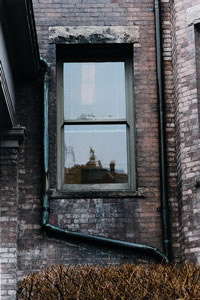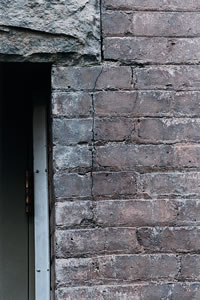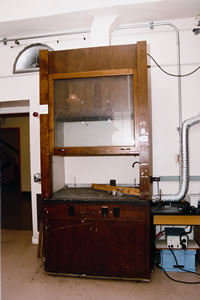
If the 2003-05 state capital budget is $1 billion, then the UW should get at least 15 percent-$150 million, they argue. This is the amount in the UW's budget request for the coming biennium.
But Gov. Gary Locke set aside only $10 million from traditional funding sources in his December budget plan-about 1 percent of the total available. "It's a disappointing number," says a grim Cox. "We're hoping that this is not the final outcome."

Water leaks are slowly eroding away the mortar between bricks in Clark Hall. Photo by Kathy Sauber.
"It's the worst capital budget plan in the history of the University," adds Dick Thompson, '68, the UW's director of government relations. "It appears that the state is not willing to take care of its own property."
Locke did present a plan to float capital bonds based on state lottery revenue. If the Legislature went along with that idea, it would fund the $50 million Johnson Hall renovation and other capital projects at state universities.
But Cox is wary of the lottery scheme. "This is a new funding source that doesn't currently exist. I really don't know how the Legislature is going to receive it," she says. "I'd give it a 50-50 chance of passing," adds Thompson.

Cracked bricks in one of the oldest buildings on campus -- Clark Hall. Photo by Kathy Sauber.
There is some hope for relief. In late December, former governors Dan Evans, '48, '49; and Booth Gardner, '58, announced an innovative plan for financing higher education construction by raising the state's debt limit (see "Blue Sky Amid the Gloom"). "Their plan takes care of existing facilities as well as preparing for growth. It's important that the state supports its existing facilities well," Cox says. But that plan, too, could run into roadblocks in Olympia.
This month, Jackie White will take more potential students and their families on campus tours. She says she is glad that Suzzallo Library is open after a two-year restoration and seismic upgrade. "When I take them inside the Suzzallo Reading Room, their eyes light up and their faces break into big smiles. They get such a good feeling that there is a place like this on our campus."

A 1930 wooden fume hood with asbestos lining sits in a Johnson Hall lab. Photo by Kathy Sauber.
The $47 million restoration of Suzzallo Library is a case study of how to renovate campus treasures-staying true to the original architecture while making sure the building meets the needs of 21st century education. Farsighted legislators funded the renovation in 1999.
But will that effort be the last UW renovation project funded by the state? "Something has to be done. There is no option. I can't imagine that the Legislature will not respond to this crisis," Cox replies.
Lawmakers have been known to dodge problems in the past, and this one comes with a 10-year, $1 billion price tag. "Some of our facilitates would become unusable-some are borderline now," Cox declares. "If we weren't funded, it is too depressing to think about the consequences."
Tom Griffin has been editor of Columns for 13 years.